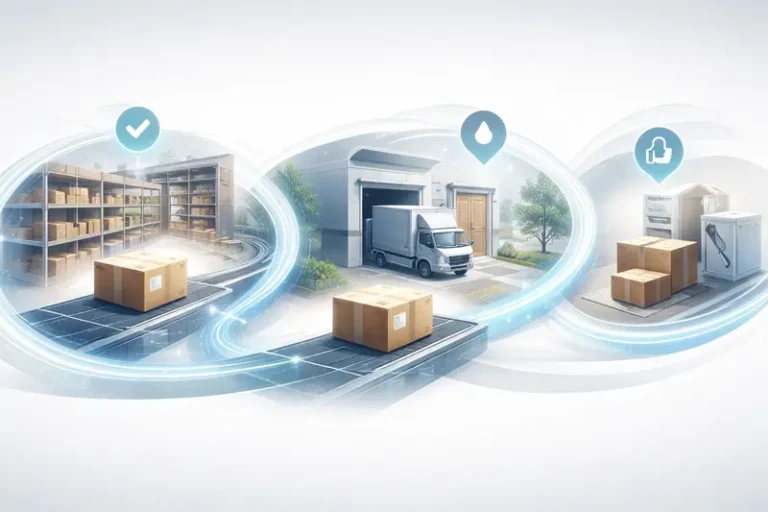What Is Dunnage: Types, Uses, and Benefits

Last updated on July 24, 2025

In this article
 13 minutes
13 minutes
- Key Takeaways
- Defining Dunnage
- Types of Dunnage Materials
- Benefits of Using Dunnage
- Choosing the Right Dunnage
- Regulatory Compliance & Safety Standards
- Reusable Dunnage Options
- Improving Shipping Efficiency with Dunnage
- Tracking Dunnage Inventory
- Cost-Effective Dunnage Strategies
- The Future of Dunnage in Logistics
- Summary
- Frequently Asked Questions
Dunnage refers to materials used to protect goods during shipping by filling empty spaces and preventing movement. In this article, we will explore what dunnage is, as well as various types such as bubble wrap, wood, and foam, their uses, and the benefits of using dunnage for safe transportation.
Key Takeaways
- Dunnage is essential for protecting goods during shipping, preventing damage by filling voids and absorbing shocks.
- There are various types of dunnage materials, including bubble wrap, wood, and air pillows, each suited for different shipping needs.
- Investing in proper dunnage not only minimizes damages and returns but can also improve shipping efficiency and compliance with regulations.
Defining Dunnage
Dunnage refers to any robust material utilized in shipping. It serves to safeguard goods from damage. Its primary role is to fill empty spaces within packaging, preventing items from shifting and sustaining damage during transport. This can include anything from preventing scratches and dents to absorbing shocks and vibrations that occur during transit. Choosing the correct amount of dunnage helps businesses significantly reduce returns caused by damages, ensuring products arrive in perfect condition.
Dunnage is not just about protecting individual products; it also plays a crucial role in the overall safety and efficiency of shipping operations. Proper dunnage and steel dunnage ensure the well-being of individuals handling the shipments and maintain the integrity of the cargo protection, including crisscrossed dunnage and floor dunnage.
Whether you’re shipping fragile items that require more material or heavy goods that need structural support, understanding the various types of dunnage materials and fragile materials available can help you make informed decisions.
Slash Your Fulfillment Costs by Up to 30%
Cut shipping expenses by 30% and boost profit with Cahoot's AI-optimized fulfillment services and modern tech —no overheads and no humans required!
I'm Interested in Saving Time and MoneyTypes of Dunnage Materials
Dunnage materials come in various forms, each with unique characteristics suited for specific shipping needs. Common dunnage materials include:
- Bubble wrap
- Solid plastics
- Air pillows
- Wood
- Foam
- Paper-based materials
Knowing these materials helps in selecting the appropriate type of dunnage, providing optimal protection and efficiency during transit.
Bubble Wrap
Still one of the most common forms of protective dunnage, bubble wrap is a versatile packing material primarily used for shock absorption, making it ideal for protecting fragile items like glass and ceramics during shipping. It’s great for wrapping individual items, though traditional bubble wrap can generate static, so avoid it for electronics. Its popularity stems from its reliability and durability; however, it is not biodegradable, and burst bubbles can lose their protective ability over long hauls.
Even with these drawbacks, bubble wrap continues to be a preferred choice for many shippers because of its effectiveness in filling packaging gaps and protecting delicate items.
Solid Plastics
Solid plastic dunnage, often made from high-density polyethylene, is used for high-value industrial shipping due to its robustness and durability. This type of dunnage is particularly effective for protecting heavy and expensive items such as electronics, glass, and ceramics. Its moisture-blocking capabilities and ability to absorb spills further enhance its protective qualities.
Although solid plastics can be pricier, their durability makes them a valuable investment for high-value shipments.
Air Pillows
Air pillows are lightweight, air-filled plastic bags that:
- Provide cushioning and protection during shipping
- Serve as an efficient gap filler (especially in relatively snug boxes)
- Keep items stationary
- Absorb shocks during transport
Air pillows provide a cheap and reusable packaging solution, though they can lose effectiveness if they pop during transit. Their lightweight nature and low cost still make them popular for less fragile items, but they collapse under pressure, so don’t use them for heavy or sharp objects.
Wood Dunnage
Wood dunnage is commonly used for transporting large machinery and appliances. It is also suitable for electronics. It serves as a barrier between heavy goods, preventing damage and stabilizing items within shipping containers. Wooden pallets, considered a form of wood dunnage, provide a sturdy base for large, heavy products like construction materials. Wood is an affordable and ethically sourced material, making it a sustainable choice for dunnage.
For international shipments, wood must be heat-treated and stamped to meet ISPM-15 compliance, ensuring it is free from pests and contaminants.
Despite the need for treatment, wood’s reusability and structural integrity make it a reliable choice for heavy-duty dunnage applications.
Foam Dunnage

When you’re shipping fragile or high-value items, foam is your best friend. Foam dunnage is ideal for protecting delicate items such as electronics, glassware, and medical equipment during transit. Die-cut foam inserts prevent movement, absorb shock, and give off a high-end feel. It comes in two primary types: open-cell foam, which is excellent for cushioning, and closed-cell foam, which offers better moisture and chemical resistance.
Although foam dunnage can be recycled and reused, it is generally less eco-friendly compared to materials like kraft paper. Its lightweight and customizable nature still makes it suitable for various applications.
Molded Pulp or Paper Pulp Inserts
These are becoming increasingly popular as a sustainable alternative to foam. They’re sturdy, biodegradable, and great for consistent SKUs (e.g. candles, skincare jars).
Anti-Static Dunnage for Electronics
If you’re shipping semiconductors, electronics, or components, this is non-negotiable, as it prevents electrostatic discharge (ESD) damage during transport. Often made from foam or plastic treated with anti-static agents, this specialized dunnage ensures that sensitive electronic components remain safe from static electricity, which can cause significant damage if not properly managed.
Paper-Based Dunnage Materials
Paper-based dunnage, made from kraft or recycled paper, is the workhorse of eco-conscious brands. It’s versatile and recyclable, making it an eco-friendly and cost-effective cushioning material designed to fill voids in shipping boxes. Bonus: it makes unboxing feel more natural and “premium” for certain audiences.
Kraft paper is known for its strong tear resistance and cushioning capabilities, making it a popular choice for many shippers. Corrugated paper offers exceptional strength for heavy items while maintaining eco-friendly properties, addressing the growing customer demand for sustainable packaging solutions. It’s ideal for multi-unit shipments or bundled SKUs, as it prevents items from bumping into each other, and can be custom-fitted to boxes for maximum efficiency.
This type of dunnage is biodegradable and recyclable, making it a more sustainable option compared to plastic dunnage. Additionally, paper dunnage often costs less than plastic alternatives while providing comparable protection. Shredded paper, cardboard, or fill, is another paper-based option, serving as a recyclable alternative to packing peanuts and offering effective cushioning for lightweight products. Often used in boutique and gifting brands, it creates a luxurious feel, supports oddly shaped items, and keeps products stable. But beware: it can be messy and increase packaging time.
Custom Dunnage Solutions
Custom dunnage is key for shipping fragile or irregularly shaped items needing specific packaging dimensions. These tailored solutions protect valuable products by providing a perfect fit, ensuring better protection and stability during transit. Custom dunnage can be made from various materials, including foam, plastics, and metals, offering flexibility based on product needs.
Customization techniques, such as CNC cutting and molding, allow for the creation of dunnage that perfectly fits irregularly shaped products with very specific dimensions. Collaboration with dunnage providers can lead to uniquely tailored packaging solutions that enhance the protection of specific cargo.
While custom dunnage is often more expensive due to its bespoke nature, it is a worthwhile investment for businesses shipping high-value, fragile items.
Looking for a New 3PL? Start with this Free RFP Template
Cut weeks off your selection process. Avoid pitfalls. Get the only 3PL RFP checklist built for ecommerce brands, absolutely free.
Get My Free 3PL RFPBenefits of Using Dunnage
Dunnage materials play a critical role in securing shipments and keeping items stable during transportation, thereby minimizing the risk of movement that can lead to damage. Investing in proper dunnage helps businesses prevent costly replacements due to damaged goods, ensuring shipments arrive safely and intact.
The benefits of using dunnage include damage protection, moisture protection, and shock absorption, all of which contribute to the safe delivery of products.
Damage Protection
Dunnage plays a crucial role in absorbing shocks and vibrations, significantly reducing the risk of damage to goods. Proper use of dunnage can prevent fragile items such as delicate electronics and ornate glassware from being damaged during transport. Air pillows and dunnage bags are commonly used for filling voids and absorbing shock, ensuring the protection of sensitive items.
This not only enhances shipping safety but also minimizes shipping costs by reducing the likelihood of damage.
Moisture Protection
Moisture-resistant dunnage is essential for protecting products during transit, as moisture can cause significant damage. Certain dunnage types are designed to protect cargo from environmental factors, maintaining product integrity to protect goods.
For example, airbags not only protect against physical impacts but also help create barriers, maintaining moisture barriers and preventing damage from spills or humidity.
Shock Absorption
Effective dunnage materials, such as airbags and air pillows, provide excellent shock absorption properties, protecting delicate items during transit. Dunnage plays a crucial role in reducing the risk of damage caused by impacts during handling, ensuring that goods can absorb shock and be delivered safely and without damage.
Choosing the Right Dunnage
Selecting the right dunnage involves assessing the characteristics of the cargo, such as its fragility, weight, and shape. Businesses need to consider the types of products being shipped, the shipping methods used, and the specific packing options available. For example, wood is favored for its strength and versatility but may require additional protective measures for moisture-sensitive cargo. Custom dunnage solutions can be created to meet unique needs, ensuring enhanced protection and stability for specific cargo.
Regulatory compliance is also crucial when choosing dunnage, as various cargo types may have specific safety and legal requirements. Careful evaluation of these factors enables businesses to select the right dunnage materials, offering the best protection and regulatory compliance.
Regulatory Compliance & Safety Standards
Adhering to regulatory standards ensures the safe and legal transportation of goods. For example, ISPM-15 regulations require that wood dunnage used in international shipping be heat-treated and stamped to prevent the transfer of pests. Additionally, OSHA has specific load securement expectations that must be met to ensure the safety of cargo during transit.
Eco-label certifications can also play a significant role in demonstrating a commitment to sustainability. By adhering to these standards, businesses can ensure that their shipping practices are both safe and environmentally responsible.
Reusable Dunnage Options
Reusable dunnage options are not only environmentally sustainable but can also reduce long-term costs for businesses. Examples include:
- Wood dunnage, a renewable resource that can be reused multiple times.
- Foam dunnage, particularly types like expanded polypropylene (EPP), which is recyclable and supports eco-friendly packaging.
- Partnering with vendors who offer take-back programs or biodegradable materials to further enhance sustainability efforts.
Proper disposal or recycling of dunnage materials minimizes environmental impact. Implementing reuse practices and partnering with sustainable vendors helps businesses manage dunnage waste and packaging waste effectively, contributing to a greener shipping industry through the use of recycled materials.
Improving Shipping Efficiency with Dunnage
Dunnage streamlines the shipping process by optimizing shipping container space and reducing shipping costs. Materials like kraft paper and packing materials are cost-effective and ensure items arrive safely by minimizing in-transit movement. Air pillows provide cushioning for fragile items, further enhancing shipping efficiency. Businesses can also use dunnage to effectively ship products while maintaining safety.
Effective inventory management systems allow for real-time tracking of dunnage materials, ensuring their availability and location are continuously updated. Utilizing technology-driven solutions enhances decision-making in dunnage management by providing visibility into stock levels and usage patterns, ultimately improving overall shipping efficiency.
Tracking Dunnage Inventory
Tracking dunnage inventory is essential for maintaining adequate stock levels and avoiding supply shortages. An inventory management system allows businesses to monitor stock levels, usage rates, and reorder points, ensuring they have the necessary materials on hand when needed. Monitoring usage rates helps businesses understand how quickly dunnage is consumed, allowing for timely reorders.
Implementing best practices can enhance dunnage inventory management, including:
- Conducting regular audits
- Utilizing automated alerts
- Maintaining accurate records
- Setting reorder points based on usage rates
These practices allow businesses to effectively manage dunnage supplies and prevent waste.
Cost-Effective Dunnage Strategies
Cost-effective dunnage strategies balance quality and cost, allowing businesses to protect products during shipping without significantly raising overall shipping costs. Some cost-effective dunnage materials include kraft paper and corrugated paper, known for their protective qualities and affordability. Using lightweight dunnage materials can also reduce shipping expenses while still providing adequate protection.
To improve dunnage usage and shipping efficiency, consider the following strategies:
- Choose appropriately sized packaging for products to minimize dunnage waste and shipping costs.
- Utilize a digital logistics platform to optimize dunnage usage and enhance overall shipping efficiency.
- Maintain accurate records of dunnage inventory.
- Use data analytics to forecast future dunnage needs, allowing better planning and resource allocation to improve cost efficiency.
Scale Faster with the World’s First Peer-to-Peer Fulfillment Network
Tap into a nationwide network of high-performance partner warehouses — expand capacity, cut shipping costs, and reach customers 1–2 days faster.
Explore Fulfillment NetworkThe Future of Dunnage in Logistics
The future of dunnage in logistics lies in technology-driven optimization. AI-based dunnage optimization tools and 3D scanning for box size and void fill prediction are already transforming the industry. These technologies allow for more precise and efficient use of dunnage materials, reducing waste and improving protection for shipped goods.
Integrating dunnage planning into Warehouse Management Systems (WMS) or Transportation Management Systems (TMS) can further enhance shipping efficiency. As the shipping industry continues to evolve, the intelligent use of automation and optimization techniques will play a critical role in achieving faster fulfillment and reduced labor costs.
Summary
Understanding and utilizing the right dunnage materials is essential for ensuring the safe and efficient transportation of goods. From bubble wrap to custom solutions, each type of dunnage offers unique benefits and applications. By choosing the appropriate dunnage, businesses can protect their products from damage, moisture, and shocks, ultimately reducing costs and improving customer satisfaction.
As the logistics industry continues to innovate, the future of dunnage will be shaped by technological advancements and a growing emphasis on sustainability. By staying informed about the latest developments and best practices, businesses can optimize their shipping processes and contribute to a more sustainable and efficient future. So, make the smart choice, invest in proper dunnage, and watch your shipping operations thrive.
Frequently Asked Questions
What is dunnage?
Dunnage is the protective material used in shipping to fill empty spaces and prevent damage to goods by absorbing shocks and vibrations. It’s essential for keeping your items safe during transit!
What are some common types of dunnage materials?
You’ve got several options for dunnage materials, like bubble wrap, foam, wood, and air pillows. Each one helps protect your items during shipping and handling.
Why is regulatory compliance important for dunnage?
Regulatory compliance is important for dunnage because it guarantees the safe and legal transport of goods while meeting specific standards like ISPM-15 for wood materials. This not only protects your shipments but also helps avoid potential legal issues.
How can businesses track their dunnage inventory?
To effectively track dunnage inventory, businesses should utilize an inventory management system that keeps tabs on stock levels and usage rates. This way, they can always ensure they have the right materials available when needed.
What are the benefits of using reusable dunnage?
Using reusable dunnage is a smart choice because it’s environmentally friendly and can save your business money in the long run. Plus, with options like wood and foam dunnage, you’re supporting sustainability while cutting costs.

Turn Returns Into New Revenue





